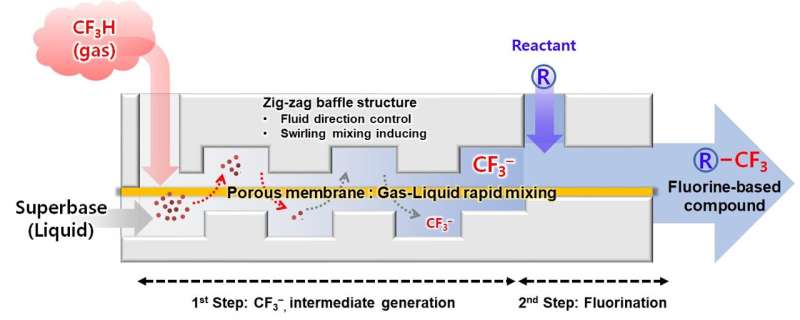This article has been reviewed according to Science X's editorial process and policies. Editors have highlighted the following attributes while ensuring the content's credibility:
fact-checked
peer-reviewed publication
trusted source
proofread
Fluorine-based novel drug synthesis at lightning speed

How short is one second? The duration of a second can be defined as one 86,400th of a 24-hour day. A bullet train traveling at 300 km per hour can cover a distance of 83 meters in one second. On average, an individual's blink lasts for 0.3 seconds, allowing for three blinks to occur within one second. A joint team of researchers from POSTECH has proposed a synthesis method for fluorine-based compound via a rapid mixing reaction between a gaseous component and liquid that takes less than a single second.
The research team led by Professor Dong-Pyo Kim and Jeong-Un Joo (Department of Chemical Engineering at POSTECH), and Professor Heejin Kim and Hyune-Jea Lee (currently, a researcher at Samsung Advanced Institute of Technology) from the Department of Chemistry at Korea University has successfully developed a new method for synthesizing trifluoromethyl intermediate (-CF3) from fluoroform (CHF3).
It involves the use of a special reactor capable of achieving an ultra-fast mixing between gas and liquid. This method offers promising prospects for the synthesis of novel fluorine-based new drugs. The research was published in Nature Communications.
Fluorine is not found in its pure form naturally, but instead exists solely in the form of various chemical compounds. Sodium fluoride, a compound containing fluorine, is used as an ingredient in toothpaste due to its ability to coat teeth and prevent cavities.
Recent studies have highlighted the potential of synthetic drug molecules containing fluorine as they possess high permeability into cell membranes of diseased tissues and exhibit strong binding affinity against proteins. Consequently, there is growing interest in the development of drugs containing fluorine.
There are several approaches to synthesizing trifluoromethyl, but the most cost-effective method involves substituting a hydrogen atom from fluoroform, a simple precursor, with another element or functional group. However, gaseous fluoroform is volatile, which makes it difficult to mix with liquids and exhibits low reactivity. Moreover, it decomposes instantly, requiring the addition of a substance that can react with it. Unfortunately, this process can result in unintended chemical reactions that lead to a low yield of trifluoromethyl.
To address the challenge of synthesizing trifluoromethyl from fluoroform, the research team developed a novel gas-liquid reactor with a zigzag-shaped channel and highly permeable non-porous membranes sandwiched between upper and lower channels. This configuration allowed for the swirling and mixing of superbase, a liquid utilized for dehydrogenation, and gaseous fluoroform within the reactor.
By breaking fluoroform bubbles into smaller pieces to increase the contact area between gas and liquid, the team was able to effectively produce trifluoromethyl anion (CF3-). Unlike traditional approaches, they produced a fluoride intermediate effectively without requiring stabilizers or additives.
The research team synthesized a fluorine-based compound by immediately adding a compound that will react with the fluoride anion intermediate. The entire process, which involved the generation of a fluorine anion intermediate from fluoroform took place within a second. The team maximized the formation of a trifluoromethyl anion, which is known to be short-lived, and rapidly facilitated the subsequent reaction before the intermediate decomposed.
This method allowed for improved yield of fluoride-based compounds and introduced a robust technique for the synthesis of fluorine-based drugs.
The research findings have significant implications for industrial applications in the economically efficient synthesis of fluoride compounds, making them more practical as well contributing significantly to studies on several unstable intermediates.
More information: Hyune-Jea Lee et al, Ex-situ generation and synthetic utilization of bare trifluoromethyl anion in flow via rapid biphasic mixing, Nature Communications (2023). DOI: 10.1038/s41467-022-35611-9
Journal information: Nature Communications
Provided by Pohang University of Science and Technology





















